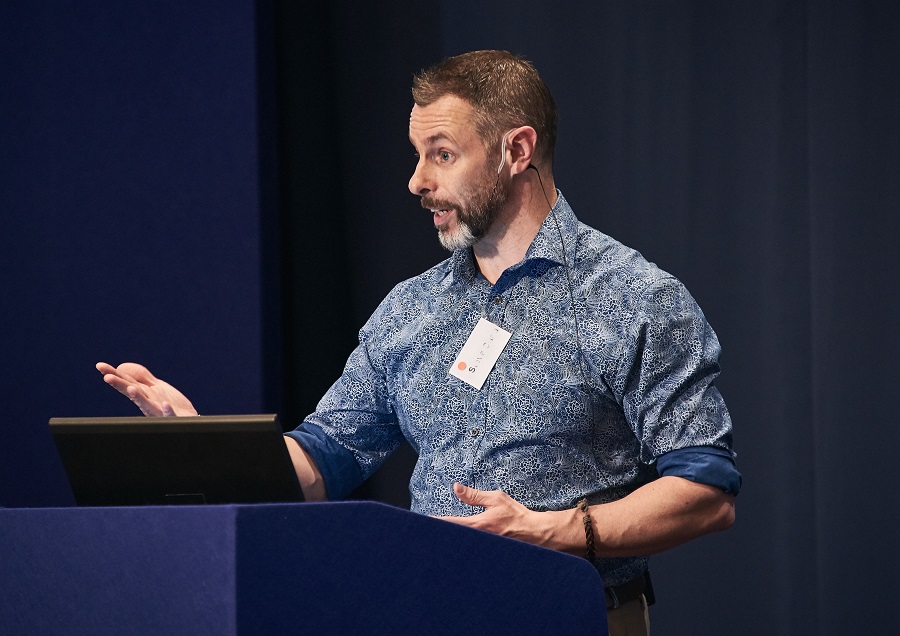Industry Talk
Regular Industry Development Updates, Opinions and Talking Points relating to Manufacturing, the Supply Chain and Logistics.Organisational Intelligence: Driving digitalisation for business development
A Q & A with Steve Chad (pictured)
Customer Engagement Manager at PFU EMEA

What is Organisational Intelligence?
Organisational Intelligence is a lens through which to view your organisation in a different way. Instead of viewing it as blocks of separate disciplines, you look at the whole thing and see what information you have and how it moves between the different parts of the business that might be able to get benefit from it. You suddenly start thinking, for instance, if marketing could understand certain logistical aspects, it might help certain decisions in terms of investment or where to focus. It’s about joining different information sets together to produce new insights.
The word ‘synergy’ is often overused, but I think it sums up much of the value of an Organisational Intelligence approach quite well. Looking at your organisation as a as a network of information pathways helps you begin to see the value in connecting siloed sets of information more easily and readily.
You can start looking at many things and see the principal fundamental dynamics at play again and again and again. And once you understand those fundamental principles, the world you’re in gets very exciting because you can spot lots of opportunities to make improvements. Sometimes those improvements are at the process level, making things more efficient. Sometimes you get extremely excited realising if we could connect these two things together, suddenly there’s a huge leap in the wisdom we can gain.
It’s about sharing intelligence between individuals, groups and systems, allowing it to be resynthesised into new, breakthrough knowledge. That is the fundamental principle at play here, and our relative level of Organisational Intelligence will underpin our ability to effectively and efficiently get the most value from both the information we have, and the capability of our people and systems. When you understand that, it’s almost like a kind of mental awakening, where you start to explore and see where else it could be applied.
What drives businesses to embark on their digital transformation journey?
In a survey by Fujitsu, 86% of respondents said they found managing the amount of information in their business a challenge. It’s because in paper format, it’s often out of sight – hidden unless you’ve got it in front of you. It’s not as searchable as digital, and we know the benefits of digitisation in terms of access, searchability, the efficiency and utility of making information more usable. But extracting business value from data isn’t just about doing the same things more efficiently. It’s also about exploring what else you can do with the data. Digitised information becomes a lot more usable in many different ways. You can put it into many, many other systems that can actually help you get a lot more value from it.
That’s what the essence of Organisational Intelligence is all about. It’s an understanding how organisations can extract the maximum value from the data that they’ve got access to. What data do they have? How could that be used? And what would they need to do to enable this? A big part – if not the starting point for much of this data which is still locked away in physical formats, is getting it all into common digital systems that can both process and manage it far more efficiently and effectively than analogue methods. Such digital systems can then analyse and interrogate it in greater depth than before, from multiple perspectives in order to quickly deliver fresh insights and wisdom. New breakthrough information that can help you gain both strategic advantage, and in the short term tactical advantage. So, the first step is making sure that we’ve got the information out of paper based media into our digital platforms. That’s why digital transformation is so high on the agenda.
How does digitalisation impact the operations and thinking of an organisation?
We know from Quocirca’s report that 44% of organisations see scanning in particular as an important foundation for digital transformation. This is probably because getting the information out of paper-based formats and into digital platforms can allow them to revolutionise not just their processes, but whole business models. You know, the insights that you get sometimes that allow you to see things that no one else can see – and that that can be quite ground-breaking.
One example we’ve seen is a case study that we had with a French bank called LCL. They were focused on their branch operations and customer experience in that customers were coming to branches to apply for financial facilities, such as loans or mortgages. They would have to fill out a paper form. That form would then get picked up, shipped to a central place, input into the system and if anything was unreadable or questionable, it would be sent back. It was a very manual process, lots of repeat meetings, lots of logistical costs.
They realised that if we put a wire free connectivity scanner in each of the branches, we can move it from room to room. So the customer could just put the document in scan it, get it up on screen straight away and be able to verify in the moment. ‘Yes, that’s gone to the database, great!’ It saved them €4 million a year on logistics costs and operational efficiency alone by putting this into their branches across France. But it also massively improved their customer experience. Customers came in once, got the job done and knew everything had been verified as complete. No need to return to branch repeat the process due to input errors.
Digitisation changes the way people look at how data is processed. Understanding the nature of Organisational Intelligence offers even more than that; opportunities for discussion as to how data could be utilised.
What is the Organisational Intelligence Maturity Index? How does it help an organisation on its digital transformation journey?
When we were developing the idea of Organisational Intelligence, one of the things that came out was that a lot of organisations were struggling to simply understand what digital transformation was in the first place. That’s understandable, because it was quite a new term, and also quite an abstract one. For us, they key lay in the word transformation. This told us it wasn’t just about how a process can be improved via digital technology. It was about strategic impact. About how understanding of the capabilities of digital technology could be applied to add value beyond a single discrete process at a single point in time. Adding value to multiple other processes – whether directly downstream, or tangential. Enabling process owners to explore new areas where it could be applied, all the way through from operational, up to strategic planning.
Waking them up to the prospect of what could be possible – that exciting mindset of asking ‘what if’ – and priming them to be able to continually explore in this way again and again, into the future.
Because at this stage things began to feel like they might be getting too complex and dependent on the individual circumstances of any given organisation, we produced a simplified model. The OI maturity matrix was developed to give people a quick. at a glance, view of where their organisation was in terms of its digital transformation progress. And to give them a sense, in broad terms, of whether they felt they were on the right track, or behind the trend. And if they felt they were lagging, provide a strategic vision that could help them understand what their next steps might need to be towards enabling business transformation.
What can an organisation do to improve its organisational intelligence?
If you’ve got a system that relies upon input, then the quality of the input usually has a very direct impact on the quality of output you get. And if you’re going to be making bold decisions and investments based upon it, you’re going to want that input to be the highest quality it can be. So, to do that, you need to make sure information is being continually consistently fed in so that there’s two sort of degrees of quality on the input. There’s the accuracy and the quality, and then there’s the consistency of the actual provision.
This is where it’s vital to ensure you have a capture system that has the integrity to deliver on both of these fronts, to make sure downstream processes aren’t unexpectedly halted, and that they are not going to have any issue with the data that’s put into them. It’s all about trust and reliability. From the Quocirca research into scanning as an enabler of digital transformation, end users have indicated a growing desire to integrate capture more closely with their other information management and analytical systems. In fact, this was one of the top drivers as to which capture systems they choose – so they’re obviously seeing the benefit of a ‘de-siloed’ Organisational Intelligence approach. They want to be able to make sure different sets of information can readily flow between platforms, groups, systems, and people more easily. Automation of this workflow is great for efficiency, but making sure that these things integrate readily without excessive cost or effort is the key here.
This direction also brings another fundamental principle into play; systems theory. On the one hand, an integrated system can allow the value produced to be greater than the sum of its individual parts. On the other, it’s important to understand that the more closely you integrate different elements, the more reliant they are on one another for the whole to perform to expectations. The performance of each element suddenly becomes that much more critical. Which brings us back to the importance that should be placed on the quality of the initial data capture and input.
How is OI best deployed in an organisation? Is it just another management catchphrase?
Well, we probably wouldn’t dismiss the concept of intelligence as just an educational catchphrase. And if we remove the word ‘Organisational’ from OI, we see it’s still about just that – understanding how to further our intelligence – just in this case, among groups.
Humans tend to work best in groups, and for me, Organisational Intelligence describes one of the fundamental principles of communication that has allowed us to build incredible thriving societies – our ability to share the information we have in effective ways so that our collective wisdom can grow and make our future that much more likely to be successful. Digital is the latest technology medium that is currently enabling this dynamic, as was once the case with verbally communicated stories, cave paintings, and paper. So I would say that how your organisation captures, stores, shares and makes use of the information it has access to is key to understanding what to do. Whether that’s at an operational level – how we can efficiently get the right information to the right systems people, at the right time – or at a strategic level where an organisation’s approach to who has access to information and how that is enabled may need to be reconsidered – and policies revised.
I’d say, as with any other concept, those businesses that properly understand it stand to take great benefit from it. Of those who don’t, some will doubtless attempt or even just utilise the idea in a superficial way, with the expected results that usually accompany lip service.
Embracing OI is a truly strategic approach that needs support right from the top. Building your future based on a culture of sharing, access and empowerment produces significant, sustainable results. Staff begin to view all areas of their work in news ways that help them continually adapt through learning. In addition, how you achieve these results is not that externally apparent – precisely because of the fact that it’s based in a shift in culture and mindset – making it much harder for your competition to follow or replicate.
And the results that are possible are genuinely impressive. Being able to produce robust, data-driven insights supports bold decisions. Transformative decisions, that can transform either your business model, your organisation or sometimes your entire market in your favour.
On the one hand, you’ve got the Googles and Amazons. They’re capturing massive data on a scale that’s difficult to imagine, analysing it like crazy. And as a result, you can see they are dominating the world. I think people like Uber and Airbnb, where they looked at the market, went, ‘Hang on there. There’s an opportunity here for things to be done in a different way!’ A different, whole new business model was deployed, and they gained a lot of market share as a result. And we’ve seen how at a more local level, LCL made such huge improvements to both their logistics operations, and their customer experience.
Bringing it back to the OI approach, gaining an understanding of the key principles and dynamics at play is critical to the effectiveness of digital transformation efforts. As with any technology investment, before designing or deploying anything, conducting a thorough review of what you do and how it currently gets done, is necessary to then envision new avenues of what could be possible. And the quality of the foundations upon which your vision is built, will be key to your efforts delivering the value you expect.










